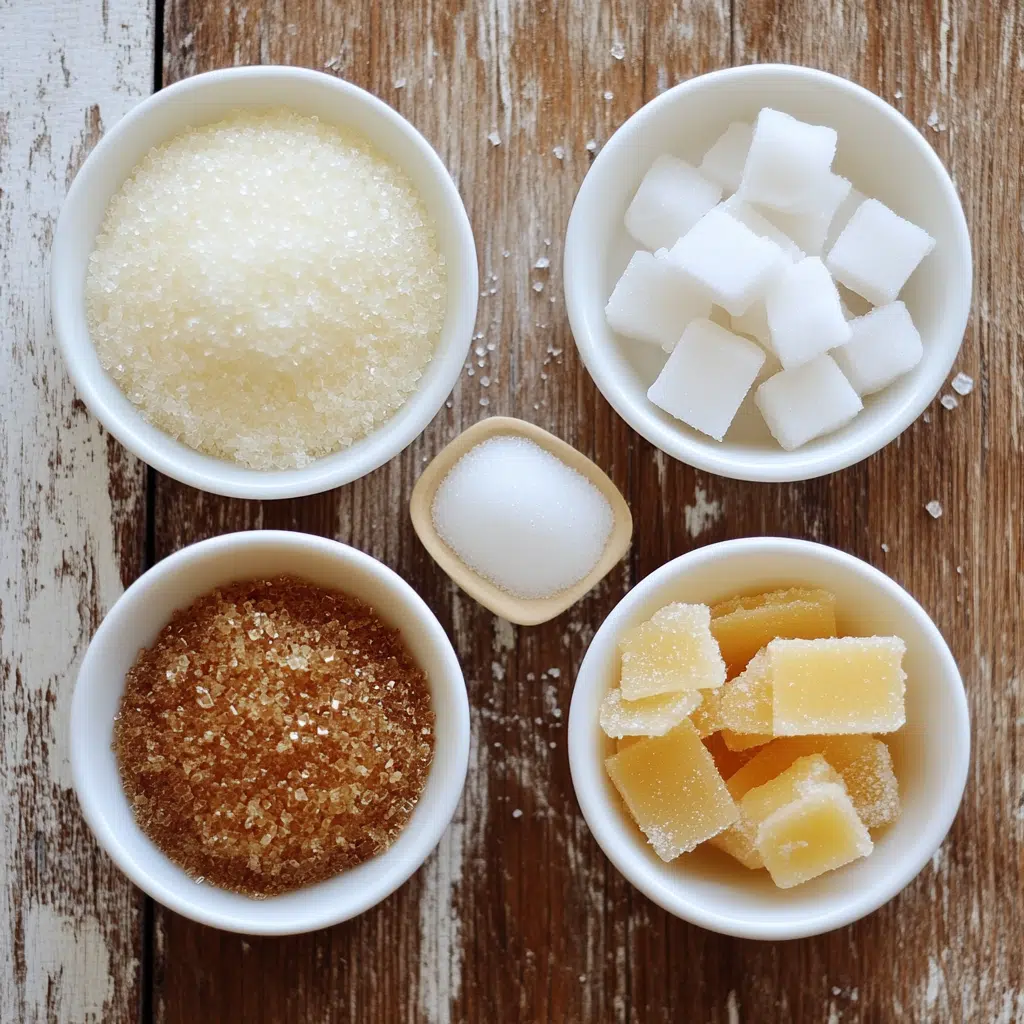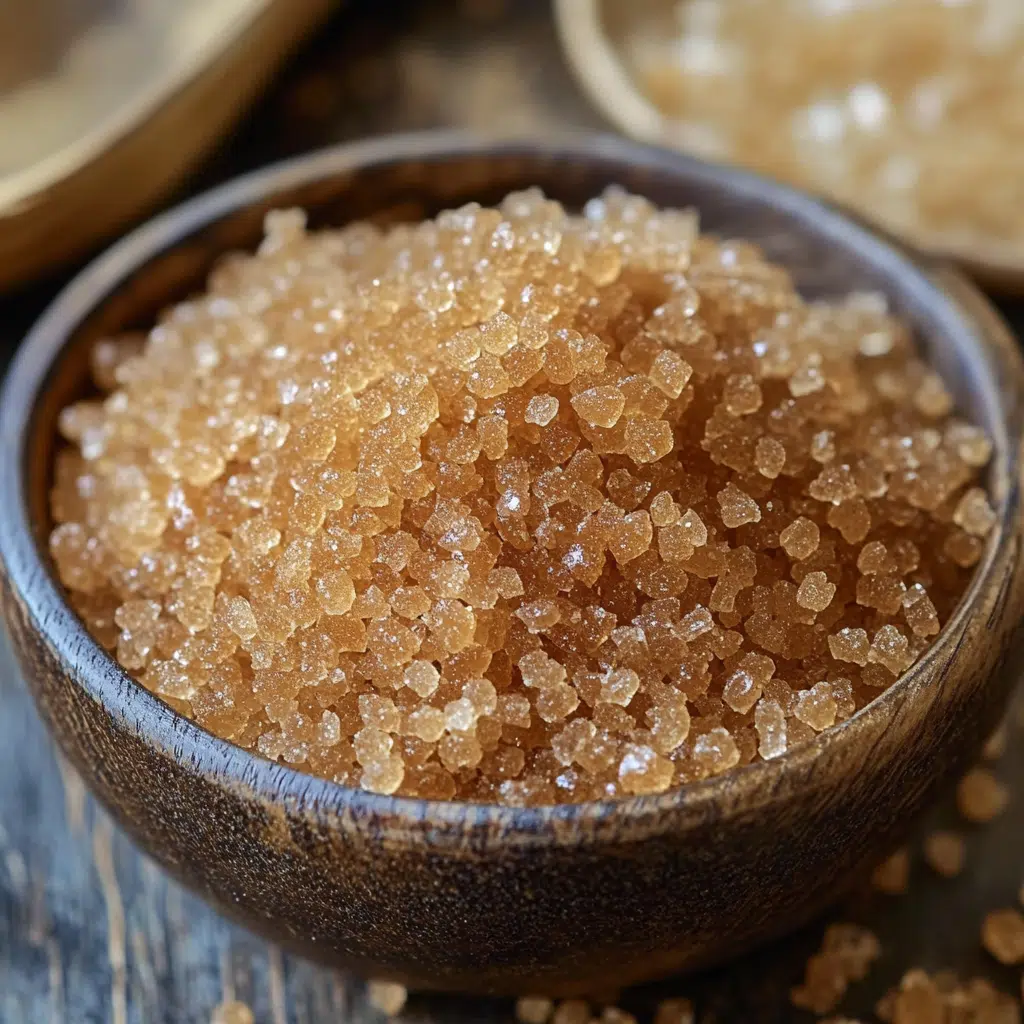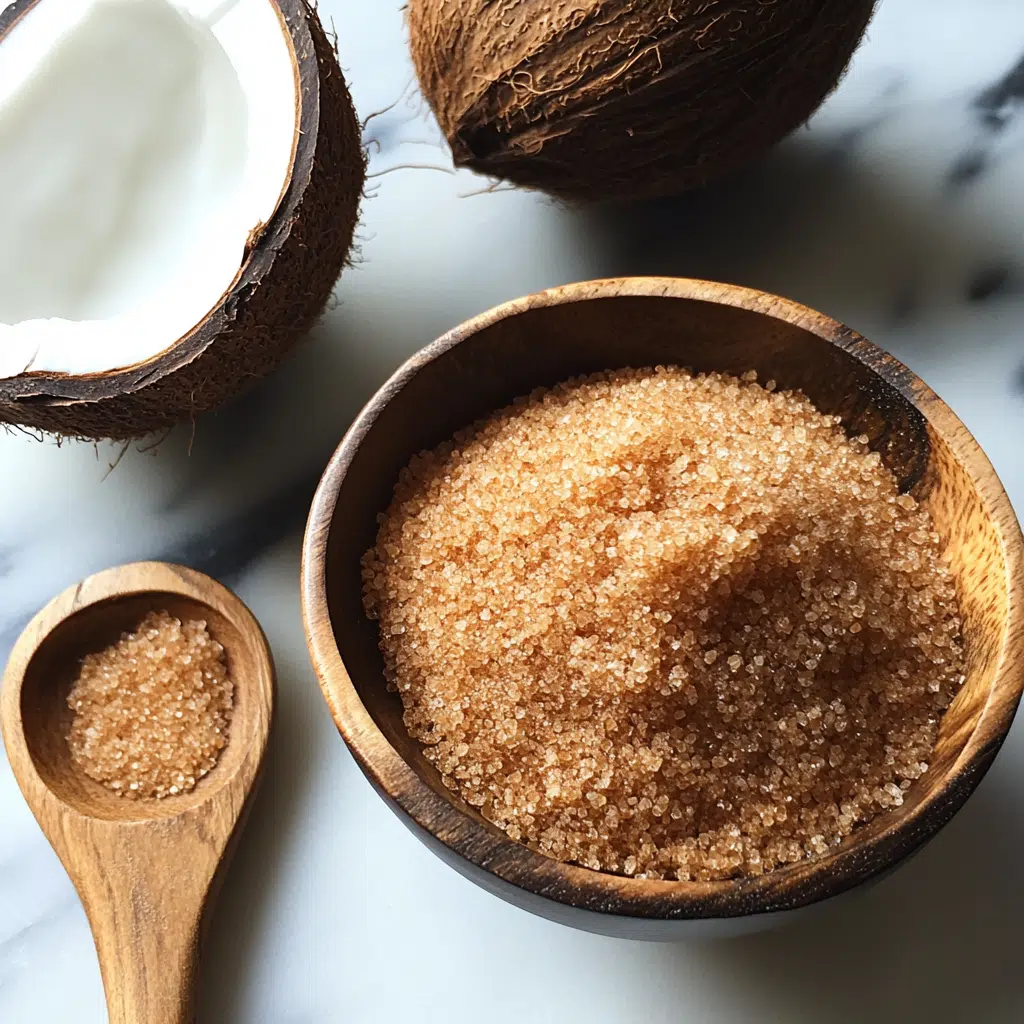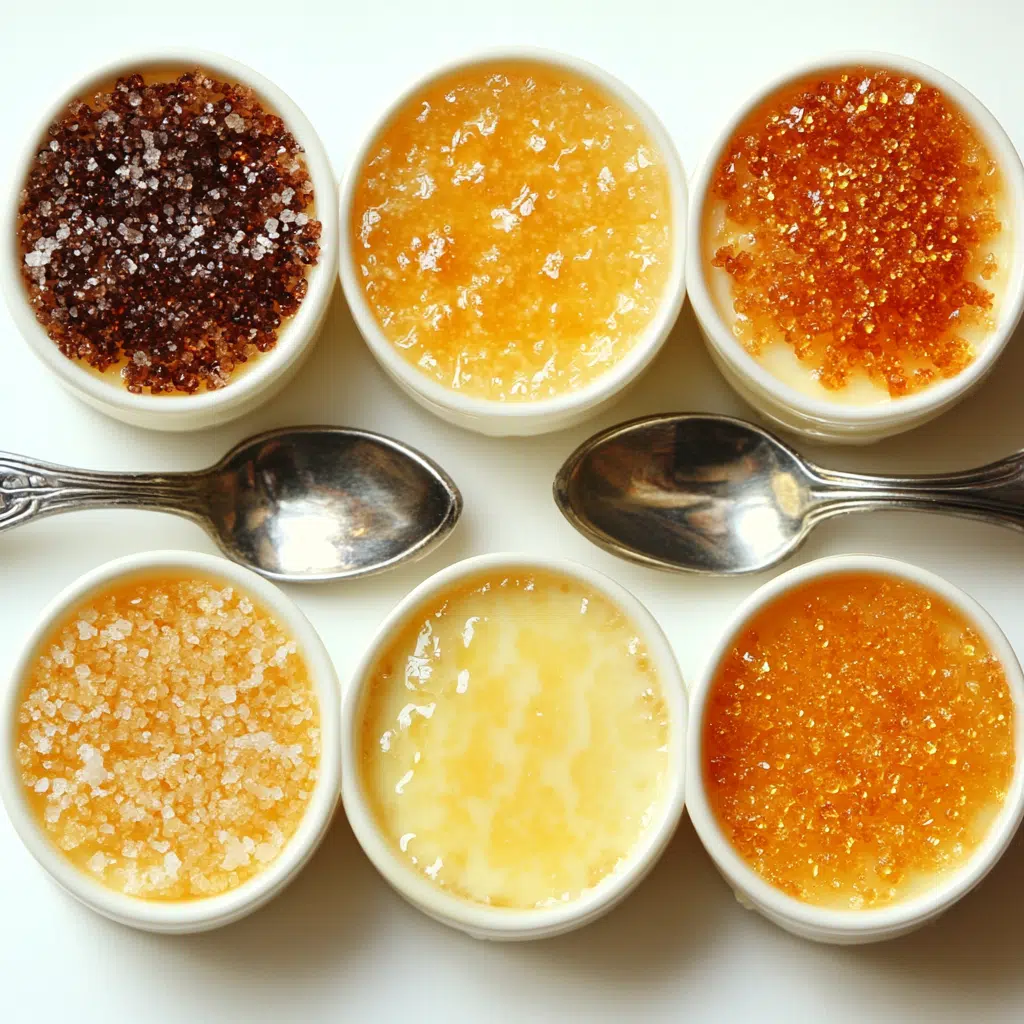Crème brûlée is a timeless French dessert celebrated for its velvety custard and a crisp, caramelized sugar topping. This topping not only adds a stunning golden finish but also delivers a delightful crunch that contrasts beautifully with the creamy base. Understanding the art behind the topping—what it’s made of, how it’s prepared, and why it works—is essential for perfecting this elegant dessert.
Table of Contents
What is the Crème Brûlée Topping Made Of?
The topping of crème brûlée is created using granulated sugar. This sugar is carefully melted and caramelized to form a thin, glass-like crust that shatters under the pressure of a spoon, adding texture and flavor.
Why granulated sugar?
- It caramelizes evenly under direct heat.
- Its fine grains allow for a smooth, uniform layer.
This caramelized topping contrasts perfectly with the custard, offering a slightly bitter-sweet flavor that enhances the creamy richness below. If you want to dive deeper into making the perfect crème brûlée, explore this step-by-step classic crème brûlée recipe that provides detailed guidance for beginners and enthusiasts alike.
Types of Sugars Used for Crème Brûlée Topping

The type of sugar you use for crème brûlée topping plays a crucial role in achieving the perfect caramelized crust. Whether you opt for granulated sugar, superfine sugar, or alternatives like brown sugar, each has unique qualities that affect the texture, flavor, and ease of caramelization.
Granulated Sugar vs. Superfine Sugar

- Granulated Sugar:
- The most commonly used sugar for crème brûlée topping.
- Its larger crystals melt evenly under heat, creating a smooth, crunchy crust.
- Ideal for beginners because it’s readily available and easy to work with.
- Superfine Sugar (Caster Sugar):
- Has finer grains than granulated sugar, which allows it to melt and caramelize faster.
- Produces a slightly smoother and thinner crust due to its fine texture.
- Perfect for those who want an ultra-refined finish.
When comparing the two, superfine sugar may save a little time, but granulated sugar remains the most reliable option for even caramelization. If you’re new to making crème brûlée, explore this step-by-step crème brûlée recipe for detailed tips on working with sugar.
Alternative Sugars: Brown Sugar and Others
While granulated and superfine sugars are the traditional choices, you can experiment with alternatives to create unique flavor profiles:

- Brown Sugar:
- Adds a deep, molasses flavor that complements the creamy custard.
- Caramelizes faster due to its moisture content but can burn easily if not monitored closely.
- Coconut Sugar:
- A less refined sugar option with a subtle caramel flavor.
- Results in a darker, slightly softer crust compared to traditional sugars.
- Demerara or Turbinado Sugar:
- Coarse-textured sugars with a golden hue.
- Produces a crunchier topping but takes longer to caramelize evenly.
If you’re curious about flavor twists, consider pairing these sugars with infused custards. Learn more about unique flavors in this guide on creative crème brûlée toppings.
How the Type of Sugar Affects the Texture
The sugar you choose significantly influences the final texture of the caramelized topping:
- Granulated Sugar: Produces a classic, even crust with a balanced crunch.
- Superfine Sugar: Creates a thinner, smoother layer that’s perfect for refined presentation.
- Brown Sugar: Results in a slightly softer topping with a bold, caramelized flavor.
- Coarse Sugars (Demerara/Turbinado): Deliver a thicker, crunchier crust but require more time and heat to melt fully.
Choosing the right sugar ultimately depends on your preference for texture and flavor. If you want to understand more about how sugar works in crème brûlée, explore this article on how caramelization transforms sugar.
By selecting the right sugar and perfecting your caramelization technique, you can achieve the golden, crunchy topping that makes crème brûlée a show-stopping dessert. Experiment with different sugars to find the one that best suits your taste and presentation goals.
How to Create the Perfect Caramelized Topping
The caramelized sugar topping is the crowning glory of crème brûlée, adding a beautiful golden crust and satisfying crunch to the creamy custard. Achieving this iconic finish requires the right tools, proper technique, and a choice between two methods: the kitchen torch or the oven broiler. Let’s break it down step by step.
Tools Needed for the Caramelization Process
To create the perfect sugar topping, you need:
- Granulated Sugar: The most reliable choice for an even, golden-brown caramel layer.
- Kitchen Torch: A handheld culinary torch gives you precision and control for caramelizing sugar evenly.
- Oven Broiler (Alternative): A convenient option if you don’t have a torch.
- Ramekins: Use wide, shallow ramekins to maximize the surface area for the sugar topping.
- Heatproof Surface: Place the ramekins on a baking sheet or another heat-safe surface for safety.
If you’re new to working with these tools, follow this step-by-step guide to crème brûlée preparation to set yourself up for success.
Steps to Caramelize Sugar on Crème Brûlée
Creating a glass-like caramelized topping is easy when you follow these steps:
- Prepare the Custard:
- Ensure the custard is completely chilled and the surface is dry. Dab off any condensation with a paper towel.
- Add the Sugar:
- Sprinkle 1–2 teaspoons of granulated sugar over the custard.
- Swirl the ramekin gently to spread the sugar in a thin, even layer.
- Caramelize the Sugar:
- With a Kitchen Torch:
- Hold the torch 4–5 inches from the sugar surface.
- Move the flame in a slow, circular motion, focusing on one area at a time until the sugar melts and turns golden brown.
- Avoid lingering too long in one spot to prevent burning.
- With an Oven Broiler:
- Preheat the broiler to high.
- Place the ramekins on a baking sheet and position them on the top oven rack.
- Broil for 5–10 minutes, rotating the ramekins every 2–3 minutes for even caramelization.
- Watch closely to avoid burning, as sugar caramelizes quickly.
- With a Kitchen Torch:
Pro Tip: Stop caramelizing just before the sugar reaches your desired color, as it continues to cook briefly from residual heat. For expert tips, refer to this guide on the secret of creating crème brûlée toppings.
Broiler vs. Kitchen Torch: Which Method is Better?
Both methods work well for caramelizing sugar, but they offer different advantages:
- Kitchen Torch (Recommended):
- Provides precision and control, allowing you to caramelize the sugar evenly.
- Delivers quick results without heating the custard underneath.
- Ideal for creating a smooth, golden-brown crust.
- Oven Broiler:
- A practical alternative if you don’t have a torch.
- Heats the custard slightly during caramelization, which may affect its texture.
- Produces a rustic, less uniform crust compared to a torch.
For the most professional results, a kitchen torch is the preferred choice. If you’re experimenting with the broiler, keep a close eye to ensure the sugar doesn’t burn. Learn more about choosing the best method in this article comparing broiling and torching techniques for crème brûlée.
By following these steps and choosing the right tools, you can create the perfect caramelized topping that makes crème brûlée a show-stopping dessert. Whether you use a torch for precision or a broiler for convenience, the result will be a deliciously crisp crust that pairs beautifully with the creamy custard.
The Science of Sugar Caramelization
The magic of crème brûlée topping lies in caramelization. When sugar is heated, its molecules break down and transform into complex compounds that give the topping its distinctive golden-brown color and rich, bittersweet flavor.
Key points to remember about caramelization:
- Temperature Matters: Sugar caramelizes between 320°F and 350°F.
- Controlled Heating: Gradual heating produces a smooth and even caramel layer.
- Flavor Development: Caramelized sugar enhances the dessert with sweet, toasty, and slightly bitter notes.
Unlike the Maillard reaction, which involves proteins, caramelization is a pure sugar process. Understanding this difference helps you master the art of heating sugar without burning it.
Common Mistakes When Making Crème Brûlée Topping
Creating the perfect caramelized topping for crème brûlée may seem straightforward, but common mistakes can lead to uneven results or burnt sugar. Avoiding these pitfalls ensures a golden, crisp crust that enhances your dessert rather than detracting from it. Let’s address the most frequent errors and how to fix them.
1. Sugar Burning Instead of Caramelizing
One of the most common mistakes is burning the sugar instead of achieving a beautiful caramelized crust. This happens when:
- The heat source is too strong.
- The sugar layer is too thick.
- The flame or broiler lingers too long in one spot.
How to Avoid Burning:
- Use a medium flame if using a kitchen torch and move it constantly in small circles across the surface.
- Start with a thin, even layer of granulated sugar—about 1–2 teaspoons per ramekin.
- If using a broiler, position the ramekins on the top rack but monitor them closely. Rotate every 2–3 minutes for even browning.
Pro Tip: Stop caramelizing just before the sugar turns completely golden-brown, as it will continue to cook slightly from the residual heat. For step-by-step instructions, check out this crème brûlée recipe guide.
2. Achieving an Even, Crisp Topping
An uneven or patchy topping can ruin the aesthetic and texture of your crème brûlée. This often occurs due to:
- Uneven distribution of sugar.
- Inconsistent heat application.
- Not allowing the custard surface to dry fully before adding sugar.
How to Achieve an Even Topping:
- Distribute the Sugar Carefully: Swirl the ramekin to spread the sugar into a thin, even layer. Avoid mounds or gaps.
- Dry the Custard Surface: Use a paper towel to dab away any condensation before sprinkling the sugar.
- Move the Heat Source Constantly: If using a torch, keep the flame moving in small, circular motions. For broilers, rotate the ramekins every few minutes.
Why It Matters: An even sugar layer melts and caramelizes uniformly, creating the signature crunch that defines crème brûlée. For more tips, explore the secrets of a perfect crème brûlée topping.
3. Tools and Temperature Mishaps
Using the wrong tools or incorrect temperature settings can prevent the sugar from caramelizing properly or result in burnt spots.
Common Mishaps:
- Incorrect Tools: A kitchen torch provides precision, while a broiler can sometimes overheat the custard.
- Inconsistent Temperatures: Using a flame that’s too high or a broiler that’s preheated too long.
- Custard Overheating: When using a broiler, prolonged heat can warm the custard, changing its silky texture.
Solutions:
- Kitchen Torch: Invest in a culinary torch for consistent results. Hold it 4–5 inches from the sugar and use controlled, circular motions.
- Oven Broiler: Place the ramekins on the top rack, but do not preheat the broiler for too long. Watch closely and rotate frequently.
- Avoid Overheating: Caramelize the sugar quickly without letting the custard warm through.
For a complete guide to torching vs. broiling, check out this resource on choosing the right method for caramelizing sugar.
By understanding and avoiding these common mistakes, you can consistently create a perfect, golden-brown crust for your crème brûlée. With careful attention to sugar distribution, heat control, and tool selection, your dessert will look and taste like it came straight from a professional kitchen.
Expert Tips for the Perfect Crème Brûlée Topping

- Dry Custard is Key: Ensure the surface of the custard is dry before adding sugar. Moisture prevents proper caramelization.
- Even Sugar Layer: Use 2 teaspoons of sugar and swirl gently for full coverage.
- Patience is Crucial: Move the torch in a controlled, circular motion. Rushing can cause burnt spots.
- Use the Right Tools: A kitchen torch gives you the most control. If you don’t have one, a broiler is a good alternative.
For those curious about related recipes or techniques, explore tips on custard desserts in this article: Is crème brûlée just flan?.
FAQs About Crème Brûlée Topping
1. What is crème brûlée topping made of?
The crème brûlée topping is made of granulated sugar, which is evenly sprinkled over the custard and caramelized with direct heat. This creates a hard, glass-like crust that adds a delightful crunch to the dessert. For a detailed recipe on making the topping, check out this classic crème brûlée recipe.
2. What is crème brûlée mostly made of?
Crème brûlée is primarily made of:
- Egg yolks (for richness)
- Heavy cream (for the velvety texture)
- Granulated sugar (sweetener for the custard and topping)
- Vanilla extract or vanilla bean paste (for flavor)
This combination creates a smooth, custardy dessert that is both indulgent and simple. Learn more about the key ingredients in crème brûlée on the following article: what is creme brulee made of?.
3. What do you put on top of crème brûlée?
The top of crème brûlée is finished with a thin layer of granulated sugar that is caramelized until golden brown. You can use a kitchen torch or an oven broiler to achieve this iconic crust. For more creative ideas, including alternative toppings, check out this guide on the secret of crème brûlée.
4. What is the brown stuff on crème brûlée?
The brown stuff on crème brûlée is caramelized sugar. By applying high heat to the sugar, it melts and browns, forming a hard, glassy crust with a sweet, slightly bitter flavor. This process, called caramelization, is what gives crème brûlée its signature crunchy topping. If you want to learn the science behind the topping, check out this article on how caramelization works.
These answers ensure clarity, link readers to helpful internal content, and maintain a strong focus on the topic, helping you rank well in search engines while providing value.
Conclusion
The caramelized sugar topping is the crowning glory of crème brûlée, combining elegance with irresistible flavor and texture. By mastering the techniques of even sugar layering and precise caramelization, you can create a topping that’s both visually stunning and deliciously crisp.
Whether you’re using a torch or broiler, understanding the science and techniques behind sugar caramelization will take your dessert game to the next level. For further inspiration and recipes, explore this comprehensive guide to crème brûlée and impress your guests with this timeless French masterpiece.
By following these detailed tips and insights, you’ll never miss the mark when creating the perfect crème brûlée topping. Happy baking!

